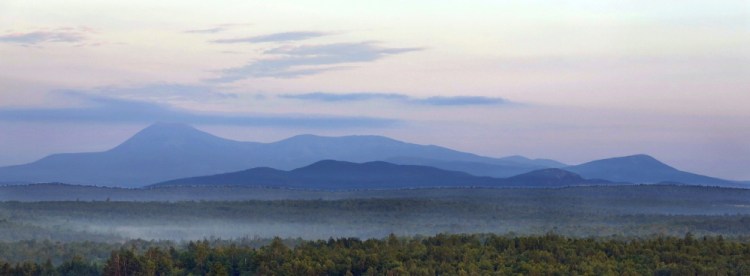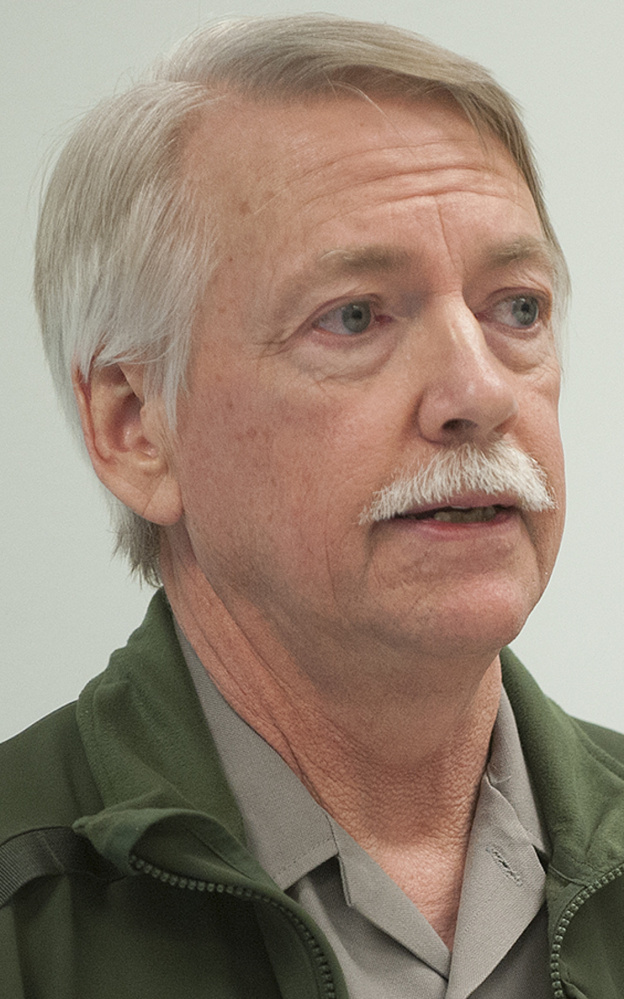The head of the National Park Service had just wrapped up a marathon day of hearings on the potential designation of 87,500 acres in Maine’s North Woods as federal land when he was asked what happens next.
“It’s absolutely being taken seriously,” Jonathan Jarvis, the nation’s top parks official, said of the proposal for a new national monument in the Katahdin region. “I can’t tell you which way it’s going to go, though.”
Plenty of people on both sides of the contentious, yearslong debate have a strong hunch, however.
“I think this is all pretty much a performance to make it look like people are being listened to,” said Charles Pray, a Millinocket Town Council member and vocal skeptic of the proposal.
“I was very heartened by the language the director used,” said Gail Fanjoy, president of the Katahdin Area Chamber of Commerce, whose board strongly supports the project. “Director Jarvis was listening and I think he was able to counter some of the negativity and falsehoods that have been going around.”
The decision of whether to add the acreage east of Baxter State Park to the National Park Service’s portfolio rests entirely with President Obama. Entrepreneur and conservationist Roxanne Quimby has offered to donate the land – and $20 million to start – to the federal government to protect the acreage as a national monument and as a potential first step to a national park.
Supporters argue that a national monument would bring tourists and jobs to an area struggling with the loss of several paper mills. But opponents have raised concerns that allowing the federal government a toehold in the region could hamper redevelopment in the area, especially for the forest products industry, while leading to restrictions on traditional outdoor activities such as snowmobiling, hunting and trapping.
Quimby’s proposal is one of several national monument designations under consideration at the White House as Obama enters the final eight months of his presidency. Jarvis stressed repeatedly last week that no decision has been made on the Maine project.
Yet he also told audiences in East Millinocket and Orono that, in his eyes, the Katahdin-region lands were “absolutely worthy of being part of the National Parks system.”
“It is worthy,” Jarvis told the crowd of more than 1,200 people – the majority of them supporters – gathered at the University of Maine. “If you want to make the argument that it’s not worthy on the natural side, it is worthy on the cultural side.”
‘YOU FIGHT’ … THEN ADJUST
With many observers perceiving the scales as tilting toward a national monument designation, will that change the dialogue in the Katahdin region from a “yes or no” debate to a dialogue about what happens next?
Pray, the Millinocket town councilor, said his years in the Legislature as well as working for the Clinton administration taught him that “you fight the battle” and then adjust to the outcome, even if he suspects he knows that outcome already.
“I am concerned because we are seeing significant changes in the economy,” said Pray, a former Maine Senate president with decades of experience in the tourism industry. “Does it attract new jobs in this new-age economy? We’ll have to see.”
One of Pray’s major questions is whom the National Park Service will select to serve on advisory boards that would be created after a designation. Pray hopes the boards would represent a cross-section of individuals and viewpoints, and not be selectively filled with monument supporters.
The issue has deeply divided Mainers. While voters in three Katahdin-area towns have expressed their opposition to a North Woods national park or monument, statewide polls suggest that the majority of voters support the proposal. Meanwhile, the issue has become a political football, of sorts, as Gov. Paul LePage criticized Sen. Angus King for facilitating Jarvis’ visit.
Bob Meyers, executive director of the Maine Snowmobile Association, said he isn’t giving up the fight.
Like many critics, Meyers questions the job-creation potential of a North Woods national monument and worries that a federal designation will lead to restrictions on access for traditional uses.
Meyers also wasn’t assuaged by the comments from Jarvis and Quimby’s son, Lucas St. Clair, that snowmobilers will have deeded access to part of the monument land. After all, Meyers said, this is a federal agency that has been fighting with snowmobilers over greater access to Yellowstone National Park for decades.
‘iT IS BIGGER THAN US RIGHT NOW’
He and others are looking forward to a planned congressional “field hearing” – slated for 2 p.m. June 1 at the East Millinocket town office – featuring members of the U.S. House of Representatives’ Committee on Natural Resources. The committee agreed to visit Maine at the behest of Rep. Bruce Poliquin, R-2nd District, who has accused the Obama administration of ignoring the will of local residents.
“I’d like to think that somehow or another, Congress can get a handle on this thing,” Meyers said of the president’s ability to unilaterally designate national monuments. “I think (local residents) will get a chance to have their say at this committee hearing. This is their lives.”
Jesse Dumais, another Millinocket Town Council member, told Jarvis and the East Millinocket audience that the “elephant in the room” was that this decision was largely out of their hands.
“We have a voice, but we don’t have a choice,” said Dumais, who has taken no position on the issue because his constituents are so divided. “It is bigger than us right now on the national level.”
Speaking to a reporter several days later, Dumais said he hopes Jarvis was truthful when he said no decision had been made. He is “conservatively hopeful” that any monument will help improve the local economy, but added “we need to be diversified and not put all of our eggs in one basket,” as happened in the past.
Dumais also believes it is time for the region to focus its attention on other pressing issues – such as shrinking schools, aging infrastructure and luring other types of job creators – since the decision is out of their hands.
“I think we can be more constructive with our time by focusing on things that we can realistically change,” Dumais said during an interview.

Wildlife abounds in Katahdin Woods & Waters Recreation Area. A parcel owned by Elliotsville Plantation Inc. is being considered for national monument status.
CONCERNS OVER MANAGEMENT PLAN
Jarvis did not give a time frame for a decision, apart from saying it would likely come before the new president is sworn in on Jan. 20.
During the East Millinocket meeting, several opponents criticized the Obama administration for even considering a proposal without first putting forward a management plan. They pointed out that Quimby’s 87,500 acres are surrounded on one side by Baxter State Park – a wilderness park with few roads – and by private landowners on the others.
Responding to the vocal concerns expressed at the East Millinocket meeting, Jarvis said he could not even begin to plan unless and until the designation happens. But he said local communities will have significant impact on how the property is managed.
“The best I can give you is my commitment, my personal commitment as the director of the National Park Service … that if this happens, we will be here the next day,” Jarvis told the largely skeptical audience of roughly 100 people.
“We will be on the ground, in your community to listen more and to begin to develop that plan, whatever that looks like, to help this area and the entire Katahdin region figure out its future.”
Quimby and her nonprofit, Elliotsville Plantation Inc., have pledged to donate $20 million upfront to the monument project to begin immediate work on the land once it is transferred to the federal government. They have also vowed to raise an additional $20 million for an endowment.
Typically, work on new national monuments must wait until the next federal budget cycle so that Congress and the administration can appropriate money for the project. But with Elliotsville Plantation’s offer of $20 million upfront, “all of that planning and even some of the access development can be jump-started almost immediately,” Jarvis said.
St. Clair, who has been leading Elliotsville Plantation’s lobbying efforts both in Maine and Washington, D.C., said the organization will continue to work with members of Maine’s congressional delegation on the issue.
DELEGATION’S MIXED RESPONSE
To date, the only member of the state delegation to endorse the plan is Rep. Chellie Pingree, D-1st District. Sen. Angus King, an independent who organized and moderated Monday’s meetings with Jarvis, said he has moved from skeptical to “listening,” but added that Jarvis addressed many concerns he’s heard from the community. Sen. Susan Collins, R-Maine, continues to harbor serious concerns about the designation and the president’s role.
“There is a real opportunity here,” St. Clair said. “The sooner this gets done the better, because we can get people working.”
Fanjoy, president of the Katahdin Area Chamber’s board of directors, hopes the local community will embrace a designation, if it happens, and learn from the experiences of similar communities that have gone through this process. Fanjoy liked the idea of inviting representatives of some of those communities to the Katahdin region to discuss what to expect, what works and what doesn’t.
But regardless of the outcome, she hopes Obama makes a decision soon.
“It’s been very difficult. This issue has pitted neighbor against neighbor and family member against family member for some time,” Fanjoy said. “This has been very divisive and continues to be, so I think whatever they do, they should do it quickly because we need to heal and move on.”
Send questions/comments to the editors.





